In Windows 8 and Windows 8.1, the Start Screen is designed as a touchscreen-friendly Start menu replacement. It focuses on the concept of pinning. Everything must be pinned to the Start screen and it appears as a tile. Earlier in Windows 8 RTM, it pinned every single installed app automatically, creating a real mess of random icons splattered all across the Start Screen. Thankfully, in Windows 8.1, Microsoft has changed this behavior. Windows 8.1 does not pin anything automatically, so you are able to keep your Start Screen well organized. With help of apps like Pin to 8, you can even pin any file, folder or system location.
If you want to change the way your Start Screen is organized, you may want to reset its layout to the defaults. It's pretty easy to do this.



